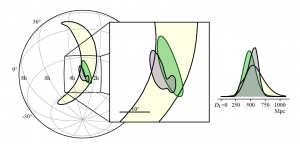First detection of a gravitational wave by Advanced VIRGO
27-09-2017
First simultaneous detection of a gravitational wave by the two US-based Advanced LIGO interferometers and the Advanced VIRGO European interferometer was announced during the meeting of Ministers of Science from the G7 countries. The observation made possible to roughly locate source of the emission, which marks a new era in astrophysics. PolGraw, a team of scientists from 8 research institutions in Poland, is a member of the VIRGIO collaboration.
Advanced VIRGO joined Observational Run 2 (November 30, 2016 – August 25, 2017) on August 1, 2017. Earlier the run was conducted only by both Advanced LIGO interferometers. Automatic analysis software detected gravitational waves within the LIGO data acquired on August 14, 2017 at 10:30:43 UTC. The GW170814 signal was later confirmed by analysis of the VIRGO-acquired data. The signal is compatible with the model predicted for an event of merging two black holes of a double-hole system. The GW170814 event is the first observation made simultaneously by all three interferometers.
Gravitational waves were generated in the process of merging two black holes, one of a mass of about 31 Sun masses with another of a mass of about 25 Sun masses. The holes were located about 1,8 billion light years away in the Eridanus equatorial constellation (only a part of it is visible from the territory of Poland during the wintertime only). Mass of the produced black hole was about 53 Sun masses, which means that about 3 Sum masses were carried away in the form of energy of the emitted gravitational waves.
GW170814 was the fourth observation of a merger of both holes of a double-hole system announced by the LIGO and VIRGO scientific consortia and the first one registered by the Advanced VIRGO detector. Global network of three detectors (two Advanced LIGO plus one Advanced VIRGO) has offered improved performance, in particular has made possible to better locate source of the observed waves in the skies and to do some new tests of the general relativity theory.
GW170814 marks the beginning of a new, exciting era in the astronomy of gravitational waves. The era is coming true before our very eyes. Great hopes for that new science field are associated with the next Observational Run 3 to be started in about year.
The discovery was announced at a press conference held during the meeting of Ministers of Science from the G7 countries. The meeting was held in Venaria Reale near Torino (Italy) on September 27-28, 2017. Prof. Andrzej Królak, the PolGraw team leader, attended the ceremony.
Polish scientists in the VIRGO project
The POLGRAW team cooperating with the VIRGO consortium since 2009 is composed of scientists and engineers from Polish Academy of Sciences Mathematics Institute, Polish Academy of Sciences Copernicus Astronomical Centre, NCBJ, AGH University of Science & Technology in Cracow, University in Białystok, Jagiellonian University in Cracow, Copernicus University in Toruń, Warsaw University, Wrocław University and Zielona Góra University. Polish researchers are developing data analysis algorithms, constructing electronic circuitry, conducting noise analyses.
How gravitational waves are detected
The VIRGO detector located close to Pisa (Italy) consists of two perpendicular arms buried in tunnels each about 3 km long. Each detector arm is terminated on both ends with mirrors. Laser beams traversing the tunnels reflect many times from the mirrors. Gravitational waves slightly change relative optical path lengths, differently in each tunnel. Such changes may be observed by means of interference of two superimposed laser beams.
The US-based LIGO detectors operate identically.
Global network of three detectors makes possible to locate source of the observed waves in the skies by means of measurement of time differences between moments the waves are arriving to each detector.





